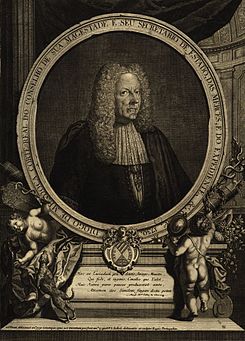Diogo de Mendonça Corte-Real
FC | |
|---|---|
 | |
| Secretary of State of Portugal | |
| In office 24 September 1704 – 9 May 1736 | |
| Monarchs | Peter II John V |
| Preceded by | Manuel Pereira |
| Succeeded by | João da Mota e Silva |
| Personal details | |
| Born | 17 July 1658 Benfica, Lisbon, Portugal |
| Alma mater | University of Coimbra |
| Profession | Statesman, Diplomat |
| Signature | |
Diogo de Mendonça Corte-Real (17 June 1658 – 9 May 1736) was an accomplished
Biography
Diogo de Mendonça Corte-Real was born in 1658, in
Corte-Real's high level of intelligence had been manifest since his early schooling. He enrolled at the
Diplomat
On 3 March, that same year, Corte-Real embarked to the Dutch Republic. On 14 April, as they sailed across the coast of England, the ship ran aground on a sandbank. The danger was imminent. Panic took over the passengers and crew, but Corte-Real kept his calm, and helped the officers overseeing the evacuation procedure. Corte-Real, his family, and the captain left the ship aboard a boat, the rest of the crew aboard another boat. The ship foundered, and the two boats spent the night adrift until morning, when their occupants spotted the English coastline. Corte-Real travelled to London, where he departed for The Hague.
Diogo de Mendonça Corte-Real proved to be efficient in dealing with the difficulties that arose between Portugal and the Dutch Republic. After a series of conferences about the matter, on 22 May 1692, the diplomat achieved the goal of his mission when the two nations signed a treaty in which the Dutch Republic paid eighty-thousand patacas as compensation for all the attacks on Portuguese ships.
The success of this mission earned him praise from the Portuguese King. The King, who had wanted send an envoy to the Spanish Court, saw Corte-Real fit to the task, and named him as such in 1693. Corte-Real stayed at the Spanish Court until 1703, year in which he returned to Portugal on account of the death of King
On 2 April 1701,
Secretary of State
King Peter II died on 9 December 1706, and
Mendonça Corte-Real married D. Teresa de Bourbon, widow of Álvaro da Silveira e Albuquerque, colonel of the regiment in Cascais and Governor of Rio de Janeiro, in October 1718. Their first daughter, D. Joaquina de Bourbon, was baptized by D. Tomás de Almeida, the Cardinal Patriarch of Lisbon, and their first son, João Pedro de Mendonça Corte-Real, had King John as his godfather.
The diplomat was active and was in office until his unexpected death on 9 May 1736. He had been strolling through his farm in
References
- Redacção Quidnovi, com coordenação de José Hermano Saraiva, História de Portugal, Dicionário de Personalidades, Volume XV, Ed. QN-Edição e Conteúdos,S.A., 2004.
- CHAGAS, Ofir Renato das. Tavira, Memórias de uma Cidade, Edição do Author, 2004.
